Genetic Fuzzy Methodology for Decentralized Cooperative UAVs to Transport a Shared Payload
Abstract
1. Introduction
2. Problem Statement
3. UAVs with Slung Payload
4. Genetic Fuzzy Methodology
4.1. Fuzzy Logic Systems
4.2. Training Process
5. Results
5.1. Training & Validation
5.2. Testing the GFS Model
6. Conclusions
Author Contributions
Funding
Institutional Review Board Statement
Informed Consent Statement
Data Availability Statement
Conflicts of Interest
Abbreviations
| UAV | Unmanned Aerial Vehicle |
| GA | Genetic Algorithm |
| GFS | Genetic Fuzzy System |
| GFM | Genetic Fuzzy Methodology |
References
- Tuci, E.; Alkilabi, M.H.; Akanyeti, O. Cooperative object transport in multi-robot systems: A review of the state-of-the-art. Front. Robot. AI 2018, 5, 59. [Google Scholar] [CrossRef] [PubMed]
- Lee, T.; Sreenath, K.; Kumar, V. Geometric control of cooperating multiple quadrotor UAVs with a suspended payload. In Proceedings of the 52nd IEEE Conference on Decision and Control, Florence, Italy, 10–13 December 2013; pp. 5510–5515. [Google Scholar]
- Gimenez, J.; Salinas, L.R.; Gandolfo, D.C.; Rosales, C.D.; Carelli, R. Control for cooperative transport of a bar-shaped payload with rotorcraft UAVs including a landing stage on mobile robots. Int. J. Syst. Sci. 2020, 51, 3378–3392. [Google Scholar] [CrossRef]
- Gimenez, J.; Gandolfo, D.C.; Salinas, L.R.; Rosales, C.; Carelli, R. Multi-objective control for cooperative payload transport with rotorcraft UAVs. ISA Trans. 2018, 80, 491–502. [Google Scholar] [CrossRef] [PubMed]
- Weng, Y.Y.; Wu, R.Y.; Zheng, Y.J. Cooperative Truck–Drone Delivery Path Optimization under Urban Traffic Restriction. Drones 2023, 7, 59. [Google Scholar] [CrossRef]
- Zhang, J.; Sheng, H.; Chen, Q.; Zhou, H.; Yin, B.; Li, J.; Li, M. A Four-dimensional space-time automatic obstacle avoidance trajectory planning method for multi-UAV cooperative formation flight. Drones 2022, 6, 192. [Google Scholar] [CrossRef]
- Khan, A.; Rinner, B.; Cavallaro, A. Cooperative robots to observe moving targets. IEEE Trans. Cybern. 2016, 48, 187–198. [Google Scholar] [CrossRef]
- Realmuto, J.; Warrier, R.B.; Devasia, S. Data-inferred personalized human-robot models for iterative collaborative output tracking. J. Intell. Robot. Syst. 2018, 91, 137–153. [Google Scholar] [CrossRef]
- Roveda, L.; Haghshenas, S.; Caimmi, M.; Pedrocchi, N.; Molinari Tosatti, L. Assisting operators in heavy industrial tasks: On the design of an optimized cooperative impedance fuzzy-controller with embedded safety rules. Front. Robot. AI 2019, 6, 75. [Google Scholar] [CrossRef]
- Baranzadeh, A.; Savkin, A.V. A distributed control algorithm for area search by a multi-robot team. Robotica 2017, 35, 1452–1472. [Google Scholar] [CrossRef]
- Lee, H.I.; Yoo, D.W.; Lee, B.Y.; Moon, G.H.; Lee, D.Y.; Tahk, M.J.; Shin, H.S. Parameter-robust linear quadratic Gaussian technique for multi-agent slung load transportation. Aerosp. Sci. Technol. 2017, 71, 119–127. [Google Scholar] [CrossRef]
- Qian, L.; Liu, H.H. Path following control of multiple quadrotors carrying a rigid-body slung payload. In Proceedings of the AIAA Scitech 2019 Forum, San Diego, CA, USA, 7–11 January 2019; p. 1172. [Google Scholar]
- Wehbeh, J.; Rahman, S.; Sharf, I. Distributed model predictive control for UAVs collaborative payload transport. In Proceedings of the 2020 IEEE/RSJ International Conference on Intelligent Robots and Systems (IROS), Las Vegas, NV, USA, 24–29 October 2020; pp. 11666–11672. [Google Scholar]
- Aliyu, A.; El Ferik, S. Control of Multiple-UAV Conveying Slung Load With Obstacle Avoidance. IEEE Access 2022, 10, 62247–62257. [Google Scholar] [CrossRef]
- Li, X.; Zhang, J.; Han, J. Trajectory planning of load transportation with multi-quadrotors based on reinforcement learning algorithm. Aerosp. Sci. Technol. 2021, 116, 106887. [Google Scholar] [CrossRef]
- Zhan, G.; Zhang, X.; Li, Z.; Xu, L.; Zhou, D.; Yang, Z. Multiple-UAV Reinforcement Learning Algorithm Based on Improved PPO in Ray Framework. Drones 2022, 6, 166. [Google Scholar] [CrossRef]
- Sathyan, A.; Ma, J.; Cohen, K. Decentralized cooperative driving automation: A reinforcement learning framework using genetic fuzzy systems. Transp. B Transp. Dyn. 2021, 9, 775–797. [Google Scholar] [CrossRef]
- Xu, R.; Guo, Y.; Han, X.; Xia, X.; Xiang, H.; Ma, J. OpenCDA: An open cooperative driving automation framework integrated with co-simulation. In Proceedings of the 2021 IEEE International Intelligent Transportation Systems Conference (ITSC), Indianapolis, IN, USA, 19–22 September 2021; pp. 1155–1162. [Google Scholar]
- Sathyan, A.; Ma, O. Collaborative control of multiple robots using genetic fuzzy systems approach. In Dynamic Systems and Control Conference; American Society of Mechanical Engineers: New York, NY, USA, 2018; Volume 51890, p. V001T03A002. [Google Scholar]
- Sathyan, A.; Ma, O. Collaborative control of multiple robots using genetic fuzzy systems. Robotica 2019, 37, 1922–1936. [Google Scholar] [CrossRef]
- Sathyan, A.; Cohen, K.; Ma, O. Genetic fuzzy based scalable system of distributed robots for a collaborative task. Front. Robot. AI 2020, 7, 601243. [Google Scholar] [CrossRef] [PubMed]
- Sun, Y.; Barth, A.; Ma, O. An intelligent approach for a two-robot team to perform a cooperative task. In Proceedings of the AIAA Scitech 2020 Forum, Orlando, FL, USA, 6–10 January 2020; p. 1116. [Google Scholar]
- Barth, A.; Sun, Y.; Zhang, L.; Ma, O. Genetic fuzzy-based method for training two independent robots to perform a cooperative task. Intell. Serv. Robot. 2021, 14, 535–548. [Google Scholar] [CrossRef]
- Bisig, C.; Montejo, J.B.; Verbryke, M.R.; Sathyan, A.; Ma, O. Genetic Fuzzy Systems for Decentralized, Multi-UAV Cargo Handling. In Proceedings of the AIAA Scitech 2020 Forum, Orlando, FL, USA, 6–10 January 2020; p. 1117. [Google Scholar]
- Bisig, C.; Ma, O. Scalable and Robust Decentralized Cargo Transport via Genetic Fuzzy Systems. In Proceedings of the AIAA SCITECH 2022 Forum, San Diego, CA, USA, 3–7 January 2022; p. 1728. [Google Scholar]
- Sathyan, A.; Harrison, H.S.; Kiefer, A.W.; Silva, P.L.; MacPherson, R.; Cohen, K. Genetic fuzzy system for anticipating athlete decision making in virtual reality. In International Fuzzy Systems Association World Congress; Springer: Berlin/Heidelberg, Germany, 2019; pp. 578–588. [Google Scholar]
- Mayadevi, B.; Martis, D.; Sathyan, A.; Cohen, K. Predictive Maintenance of Aircraft Engines Using Fuzzy Bolt©. In North American Fuzzy Information Processing Society Annual Conference; Springer: Berlin/Heidelberg, Germany, 2020; pp. 121–128. [Google Scholar]
- Sathyan, A.; Ma, O. Genetic Fuzzy Methodology for Decentralized Multi-UAV Cooperation with Physical Constraints. In Proceedings of the AIAA Scitech 2023 Forum, National Harbor, MD, USA, 23–27 January 2023. [Google Scholar]
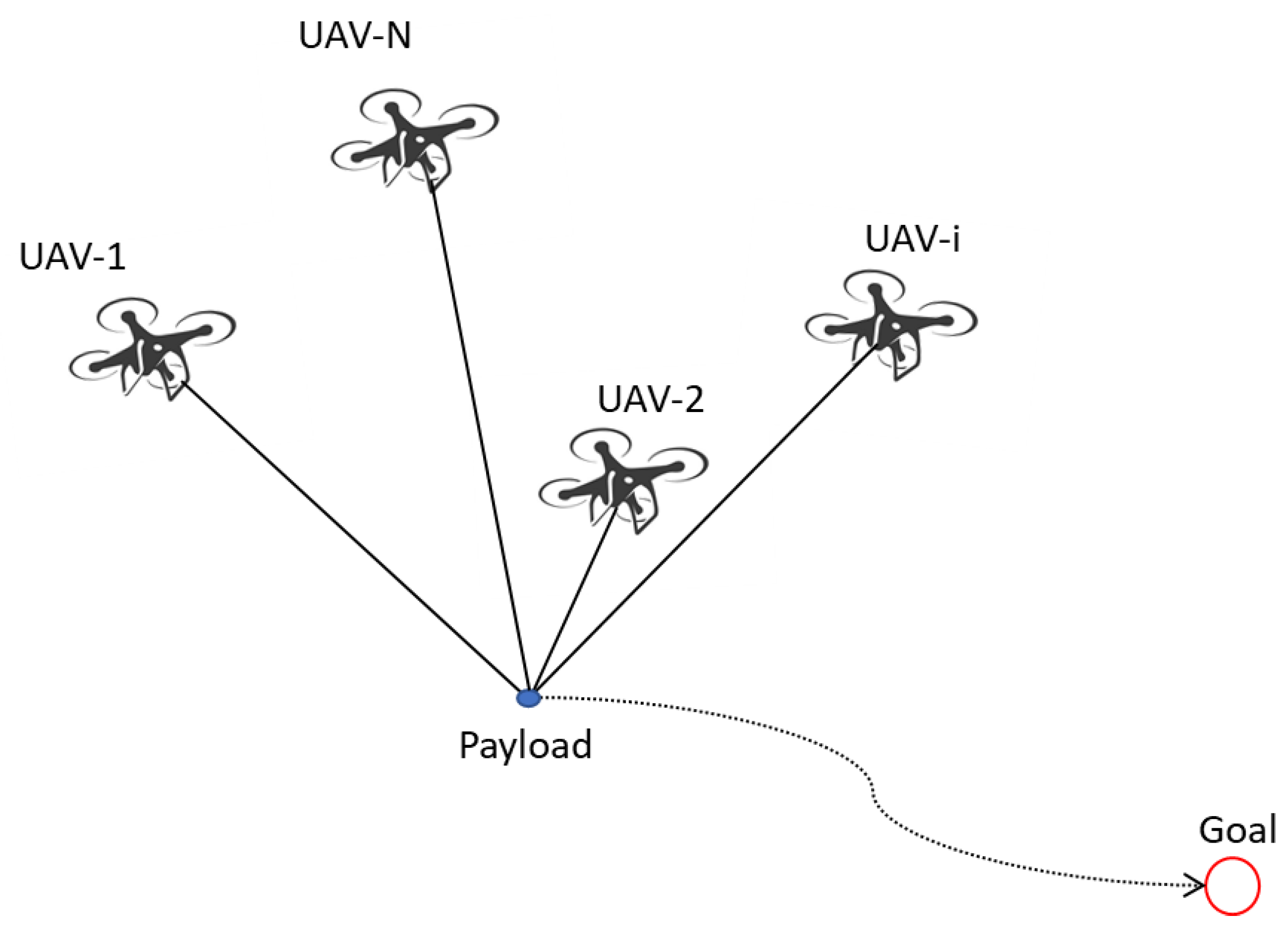
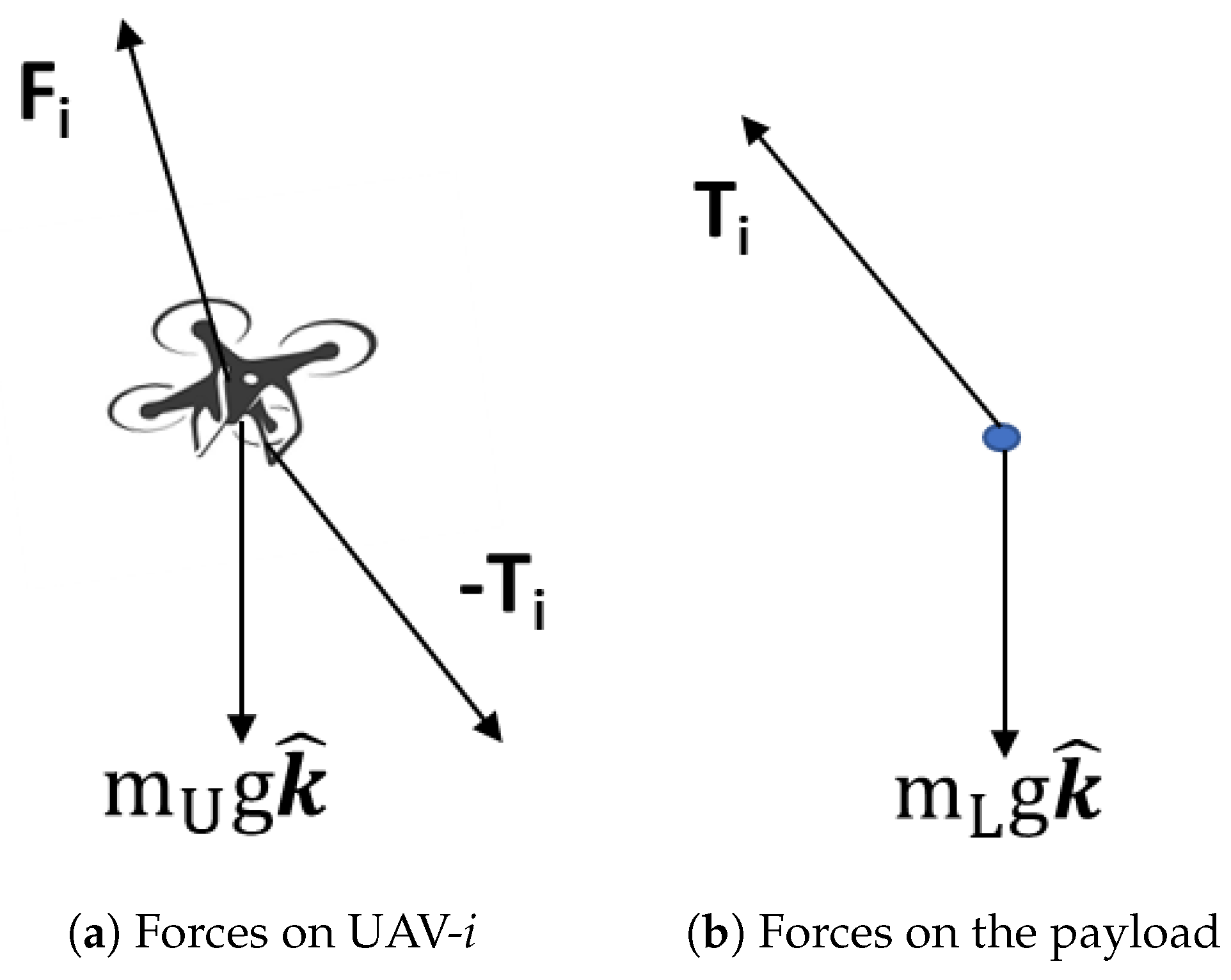
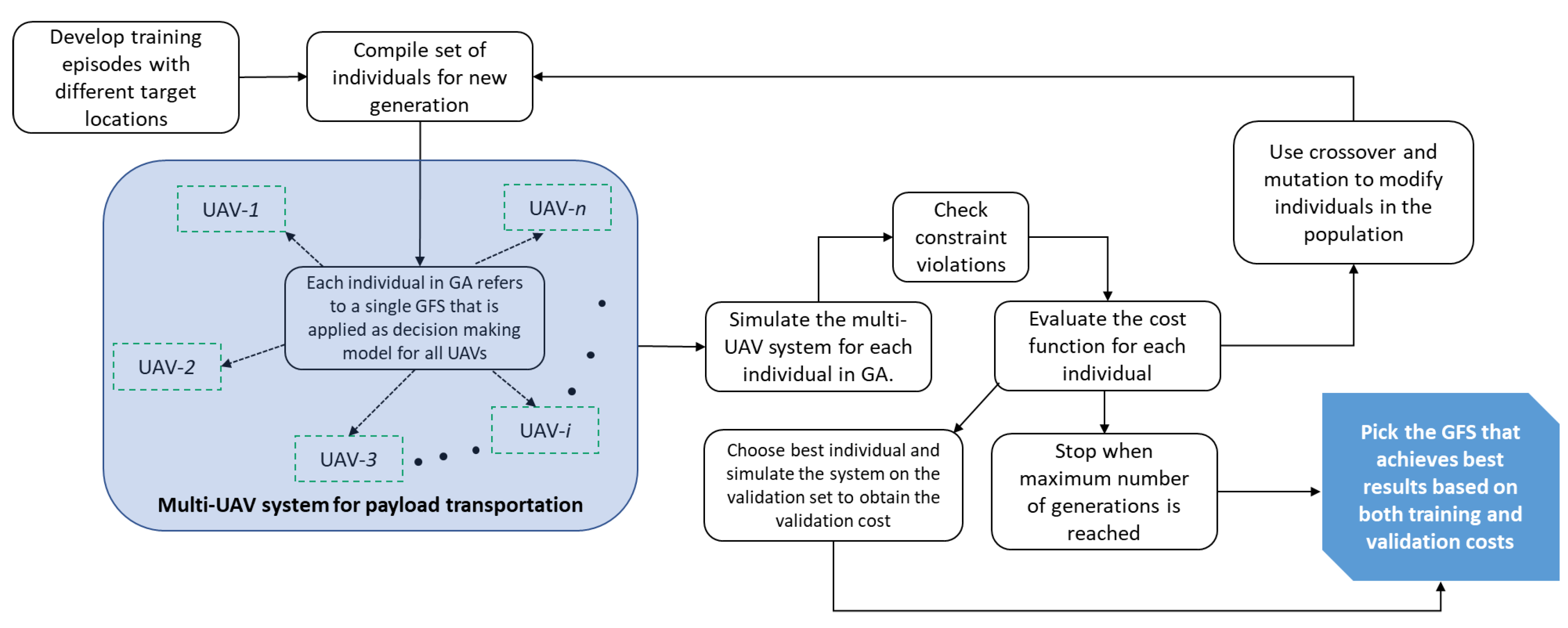
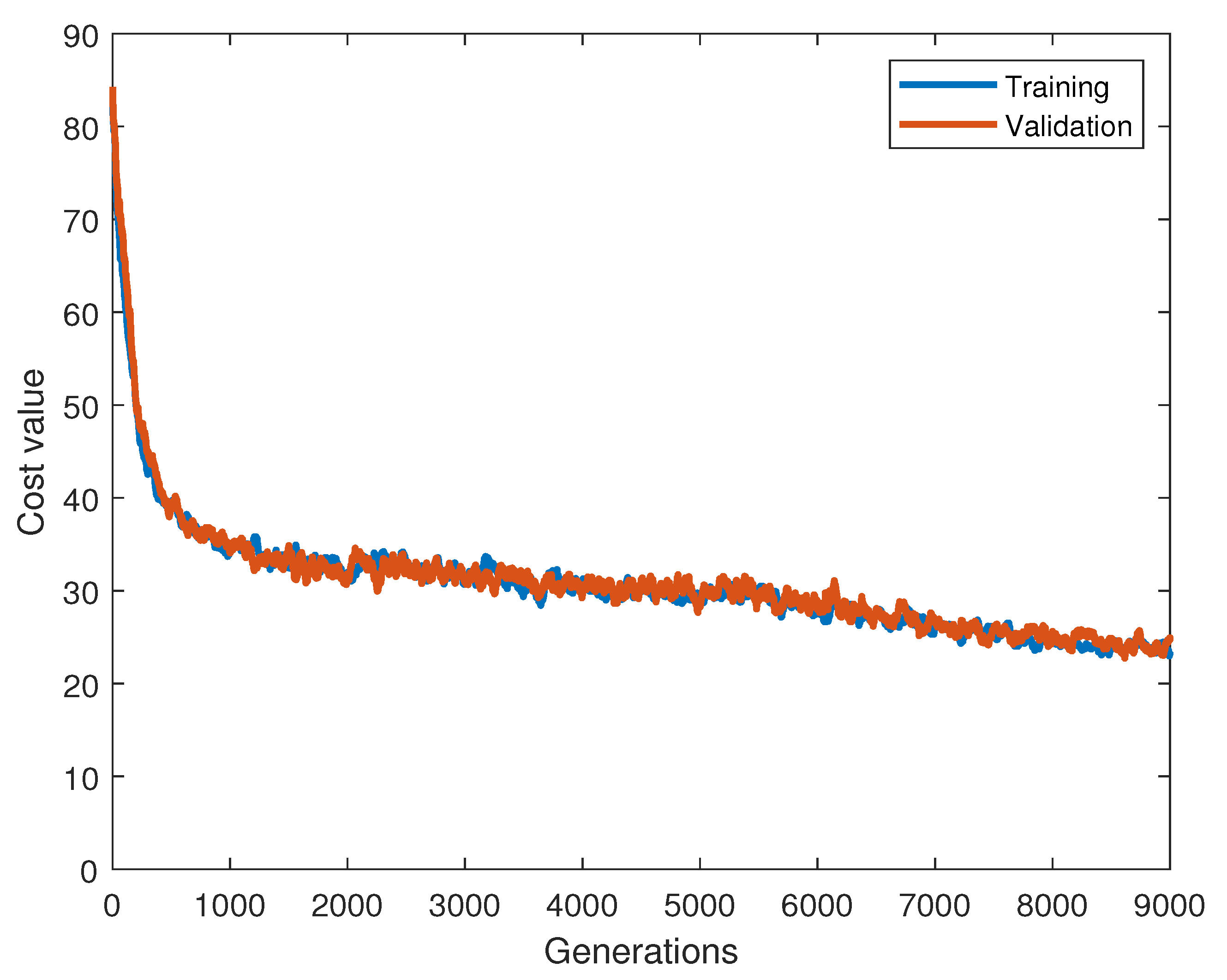



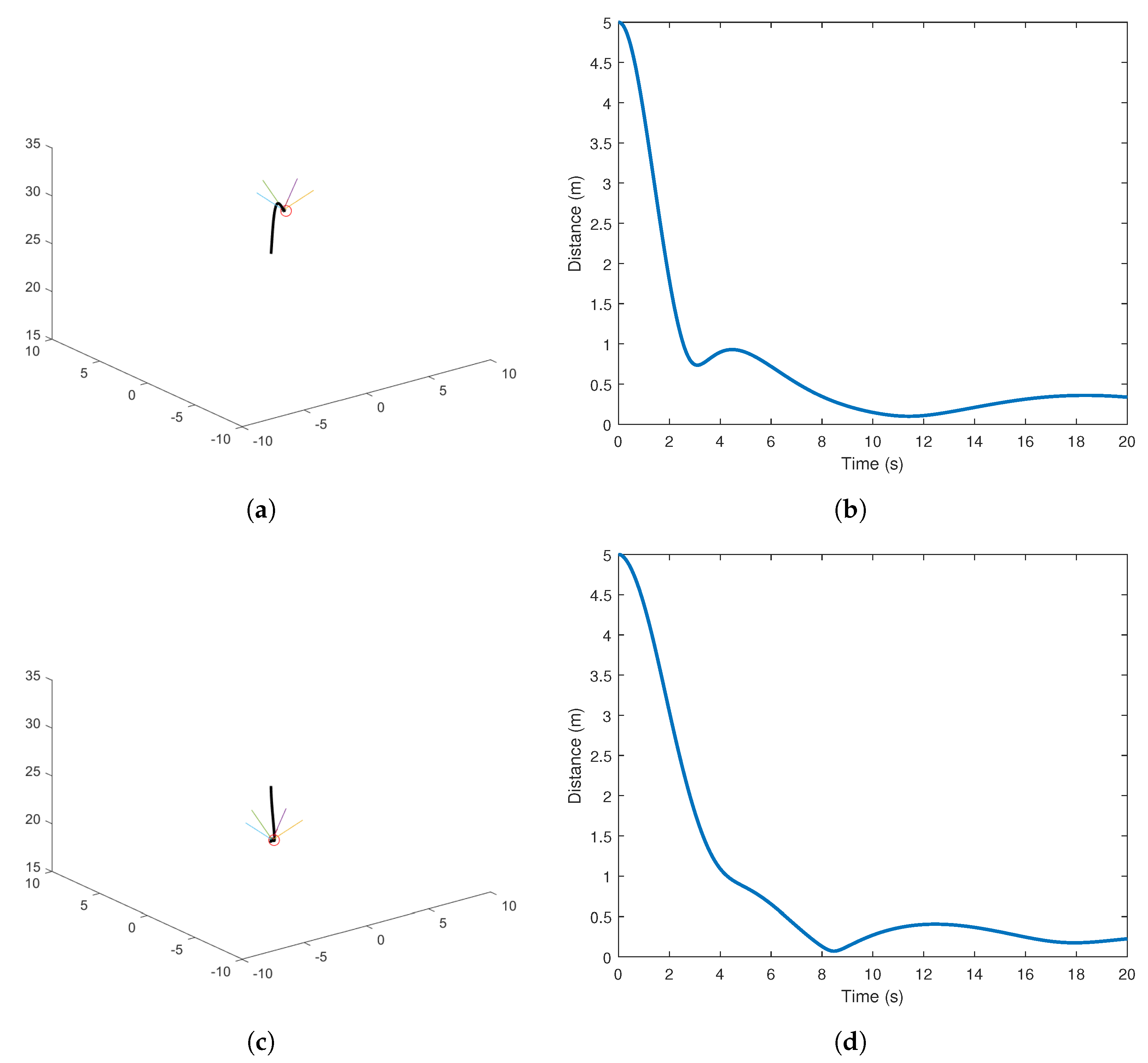


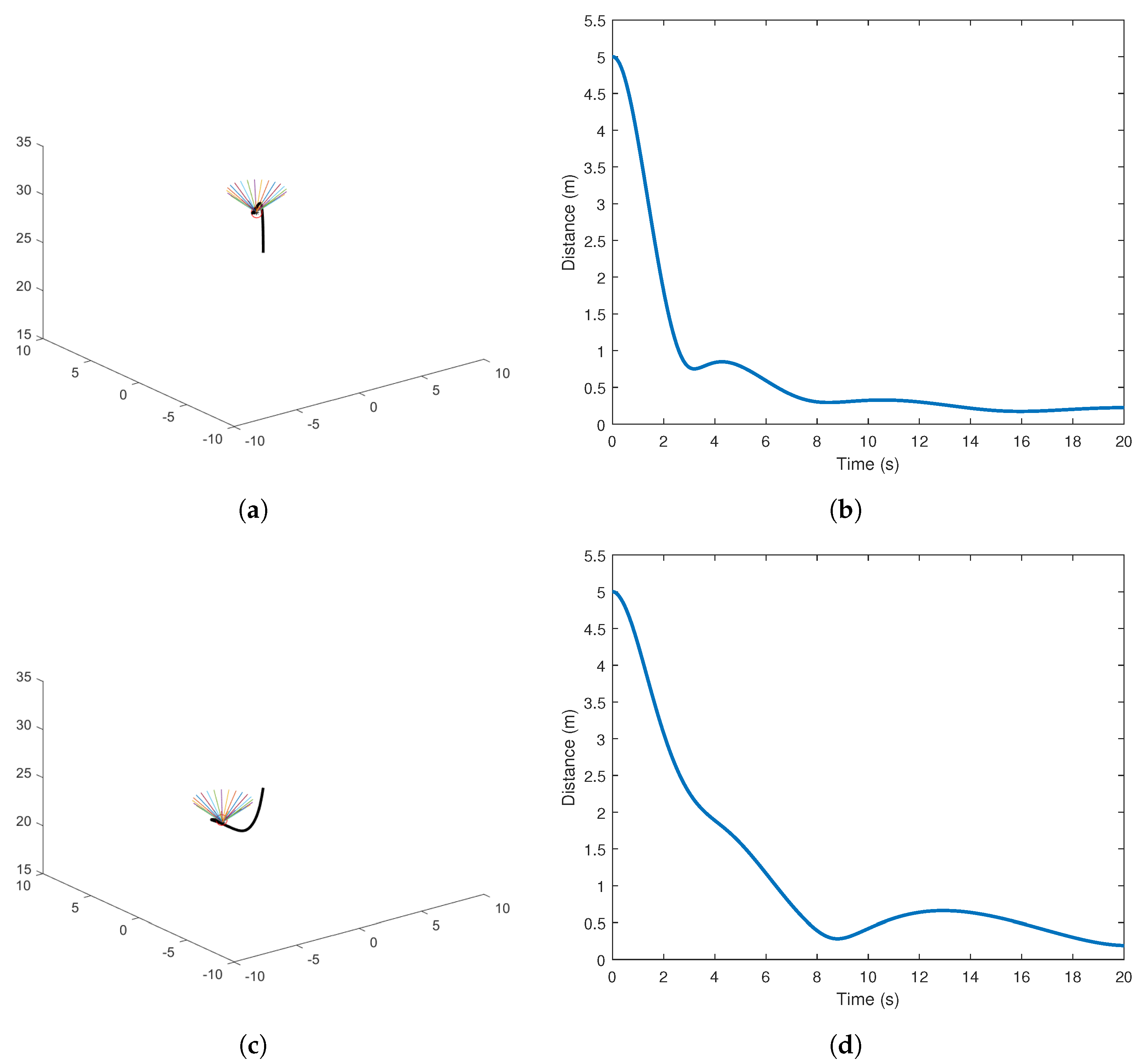
| Hyperparameters | Values |
|---|---|
| Maximum number of generations | 10,000 |
| Population size | 20 |
| Crossover method | Intermediate crossover |
| Mutation method | Uniform mutation |
| Selection method | Stochastic universal sampling |
| I1 | I2 | I3 | I4 | I5 | I6 | I7 | I8 | I9 | I10 | I11 | I12 | |||
|---|---|---|---|---|---|---|---|---|---|---|---|---|---|---|
| 1 | 2 | 2 | 2 | 2 | 2 | 3 | 3 | 4 | 1 | 1 | 5 | 1 | 3 | 3 |
| 1 | 2 | 2 | 2 | 2 | 2 | 3 | 3 | 4 | 2 | 3 | 5 | 3 | 2 | 0 |
| 1 | 3 | 2 | 2 | 2 | 3 | 3 | 3 | 1 | 1 | 3 | 1 | 0 | 4 | 2 |
| 2 | 3 | 1 | 2 | 2 | 2 | 3 | 2 | 3 | 1 | 5 | 5 | 2 | 2 | 4 |
| 2 | 3 | 1 | 2 | 2 | 2 | 3 | 2 | 4 | 1 | 5 | 1 | 2 | 3 | 1 |
| 2 | 3 | 1 | 2 | 2 | 2 | 3 | 3 | 3 | 2 | 3 | 1 | 3 | 3 | 0 |
| 2 | 3 | 1 | 2 | 2 | 2 | 3 | 3 | 3 | 2 | 3 | 2 | 0 | 3 | 3 |
| 2 | 3 | 1 | 2 | 2 | 2 | 3 | 3 | 3 | 4 | 3 | 2 | 4 | 3 | 0 |
| 2 | 3 | 1 | 2 | 2 | 2 | 3 | 3 | 4 | 1 | 5 | 2 | 2 | 3 | 1 |
| 2 | 3 | 1 | 2 | 2 | 2 | 3 | 3 | 4 | 2 | 1 | 3 | 1 | 3 | 0 |
| 2 | 3 | 1 | 2 | 2 | 2 | 3 | 3 | 4 | 2 | 3 | 2 | 3 | 1 | 1 |
| 2 | 3 | 1 | 2 | 2 | 2 | 3 | 3 | 4 | 2 | 3 | 3 | 2 | 3 | 0 |
| 2 | 3 | 1 | 2 | 2 | 2 | 3 | 3 | 4 | 3 | 2 | 2 | 2 | 3 | 1 |
| 2 | 3 | 1 | 2 | 2 | 2 | 3 | 3 | 4 | 4 | 3 | 3 | 3 | 4 | 3 |
| 2 | 3 | 1 | 2 | 2 | 2 | 3 | 3 | 4 | 4 | 4 | 2 | 3 | 3 | 3 |
| 2 | 3 | 1 | 2 | 2 | 2 | 3 | 3 | 5 | 2 | 3 | 2 | 3 | 4 | 0 |
| 2 | 3 | 1 | 2 | 2 | 2 | 4 | 2 | 4 | 1 | 3 | 5 | 3 | 1 | 3 |
| 2 | 3 | 2 | 2 | 2 | 2 | 3 | 3 | 4 | 2 | 3 | 2 | 3 | 3 | 3 |
| 2 | 3 | 2 | 2 | 2 | 2 | 3 | 3 | 4 | 2 | 4 | 5 | 3 | 3 | 3 |
| 2 | 3 | 2 | 2 | 2 | 3 | 3 | 3 | 4 | 2 | 2 | 2 | 3 | 5 | 0 |
| 2 | 3 | 2 | 2 | 3 | 2 | 3 | 2 | 4 | 1 | 3 | 1 | 1 | 0 | 1 |
| 4 | 1 | 1 | 1 | 2 | 2 | 3 | 2 | 3 | 2 | 4 | 5 | 3 | 3 | 4 |
| 4 | 1 | 1 | 1 | 2 | 2 | 3 | 3 | 3 | 1 | 5 | 5 | 2 | 3 | 4 |
| 4 | 1 | 1 | 1 | 2 | 2 | 3 | 3 | 4 | 4 | 1 | 1 | 3 | 4 | 1 |
| 4 | 1 | 1 | 1 | 2 | 2 | 3 | 3 | 4 | 4 | 5 | 1 | 3 | 3 | 0 |
| 4 | 1 | 1 | 1 | 2 | 2 | 4 | 2 | 3 | 1 | 5 | 5 | 0 | 2 | 3 |
| 4 | 1 | 1 | 1 | 2 | 2 | 4 | 2 | 4 | 1 | 3 | 1 | 3 | 1 | 0 |
| 4 | 1 | 1 | 1 | 2 | 3 | 3 | 3 | 4 | 4 | 1 | 2 | 0 | 3 | 0 |
| 4 | 5 | 1 | 2 | 2 | 3 | 3 | 1 | 3 | 2 | 5 | 2 | 2 | 4 | 3 |
| 5 | 1 | 1 | 1 | 2 | 2 | 3 | 2 | 4 | 2 | 1 | 5 | 4 | 2 | 3 |
| 5 | 1 | 1 | 1 | 2 | 2 | 3 | 2 | 4 | 4 | 1 | 2 | 3 | 4 | 3 |
| 5 | 1 | 1 | 1 | 2 | 2 | 3 | 3 | 4 | 3 | 1 | 2 | 0 | 4 | 0 |
| 5 | 1 | 1 | 1 | 2 | 2 | 3 | 3 | 4 | 5 | 3 | 2 | 3 | 3 | 0 |
| 5 | 1 | 1 | 1 | 2 | 2 | 4 | 2 | 4 | 1 | 1 | 5 | 1 | 2 | 1 |
| 5 | 1 | 1 | 1 | 2 | 2 | 4 | 2 | 4 | 2 | 1 | 1 | 2 | 2 | 0 |
| 5 | 1 | 2 | 1 | 2 | 2 | 3 | 3 | 2 | 5 | 1 | 1 | 0 | 2 | 3 |
| 5 | 1 | 2 | 1 | 2 | 2 | 3 | 3 | 3 | 2 | 1 | 1 | 0 | 0 | 3 |
| 5 | 1 | 2 | 1 | 2 | 2 | 3 | 3 | 3 | 4 | 1 | 1 | 2 | 2 | 3 |
| 5 | 1 | 2 | 1 | 2 | 2 | 3 | 3 | 4 | 4 | 1 | 5 | 1 | 2 | 3 |
| 5 | 1 | 2 | 1 | 2 | 2 | 3 | 3 | 4 | 4 | 2 | 5 | 3 | 4 | 0 |
| 5 | 3 | 1 | 2 | 2 | 2 | 3 | 2 | 2 | 1 | 5 | 5 | 2 | 3 | 4 |
| 5 | 3 | 1 | 2 | 2 | 2 | 3 | 2 | 3 | 2 | 5 | 5 | 3 | 3 | 3 |
| 5 | 4 | 1 | 2 | 2 | 2 | 3 | 3 | 3 | 1 | 5 | 5 | 0 | 2 | 4 |
| 5 | 5 | 1 | 2 | 2 | 2 | 3 | 2 | 4 | 4 | 5 | 5 | 2 | 3 | 3 |
| 5 | 5 | 1 | 2 | 2 | 2 | 3 | 3 | 3 | 5 | 5 | 1 | 2 | 4 | 3 |
| 5 | 5 | 1 | 2 | 2 | 2 | 3 | 4 | 4 | 4 | 3 | 2 | 3 | 1 | 0 |
| 5 | 5 | 1 | 2 | 2 | 2 | 3 | 4 | 4 | 5 | 5 | 2 | 2 | 2 | 2 |
| 5 | 5 | 1 | 2 | 2 | 2 | 4 | 2 | 3 | 1 | 5 | 5 | 3 | 1 | 4 |
| 5 | 5 | 1 | 2 | 2 | 2 | 4 | 3 | 4 | 2 | 5 | 1 | 3 | 3 | 1 |
| 5 | 5 | 2 | 2 | 2 | 2 | 3 | 3 | 1 | 4 | 5 | 1 | 0 | 4 | 0 |
| 5 | 5 | 2 | 2 | 2 | 2 | 3 | 3 | 4 | 4 | 5 | 1 | 2 | 1 | 1 |
| 5 | 5 | 2 | 2 | 2 | 2 | 3 | 3 | 5 | 4 | 4 | 1 | 0 | 2 | 0 |
| Team Size | Mean Settling Time (s) | Mean of the Average Distance after Settling (m) | Mean of the Minimum Distances (m) |
|---|---|---|---|
| 17.08 | 0.3522 | 0.1691 | |
| 17.82 | 0.3947 | 0.2463 | |
| 17.32 | 0.3898 | 0.2519 | |
| 17.39 | 0.3959 | 0.2564 |
Disclaimer/Publisher’s Note: The statements, opinions and data contained in all publications are solely those of the individual author(s) and contributor(s) and not of MDPI and/or the editor(s). MDPI and/or the editor(s) disclaim responsibility for any injury to people or property resulting from any ideas, methods, instructions or products referred to in the content. |
© 2023 by the authors. Licensee MDPI, Basel, Switzerland. This article is an open access article distributed under the terms and conditions of the Creative Commons Attribution (CC BY) license (https://creativecommons.org/licenses/by/4.0/).
Share and Cite
Sathyan, A.; Ma, O.; Cohen, K. Genetic Fuzzy Methodology for Decentralized Cooperative UAVs to Transport a Shared Payload. Drones 2023, 7, 103. https://doi.org/10.3390/drones7020103
Sathyan A, Ma O, Cohen K. Genetic Fuzzy Methodology for Decentralized Cooperative UAVs to Transport a Shared Payload. Drones. 2023; 7(2):103. https://doi.org/10.3390/drones7020103
Chicago/Turabian StyleSathyan, Anoop, Ou Ma, and Kelly Cohen. 2023. "Genetic Fuzzy Methodology for Decentralized Cooperative UAVs to Transport a Shared Payload" Drones 7, no. 2: 103. https://doi.org/10.3390/drones7020103
APA StyleSathyan, A., Ma, O., & Cohen, K. (2023). Genetic Fuzzy Methodology for Decentralized Cooperative UAVs to Transport a Shared Payload. Drones, 7(2), 103. https://doi.org/10.3390/drones7020103







